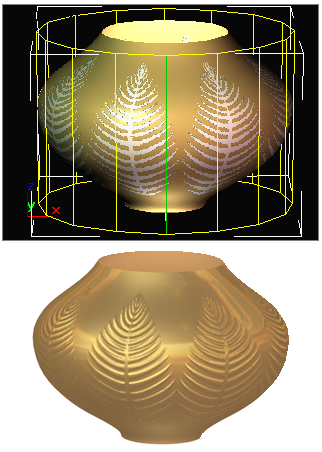Mapping coordinates specify how a map is placed, oriented, and scaled onto geometry.
Mapping coordinates are often specified in terms of U, V, and W, where U is the horizontal dimension, V is the vertical dimension, and W is the optional third dimension, specifying depth.
In general, geometric primitives have mapping coordinates applied by default, but surface objects such as Editable Poly and Editable Mesh require you to add mapping coordinates to them.
If you apply a material with maps to an object that has no mapping coordinates, the renderer displays a warning. See Missing Map Coordinates Dialog.
3ds Max provides a number of ways to generate mapping coordinates:
- When you create a primitive object, use the Generate Mapping Coords option. This option, which is on by default for most objects, provides mapping coordinates automatically with a projection appropriate to the shape of the object type.
Mapping coordinates require additional memory, so turn the option off if you don't need them.
- Apply the Unwrap UVW modifier. This powerful modifier offers a wealth of tools and options for editing mapping coordinates.
- Apply a UVW Map modifier. You can choose from several types of projection; customize the placement of the mapping coordinates on the object by positioning a mapping gizmo; and animate the transformations of the mapping coordinates.

Decoration on the vase is a map positioned by rotating the UVW Map Modifier gizmo.
Set an appropriate projection type for the geometry:
- Box projection places a duplicate of the map image on each of the six sides of a box.
- Cylindrical projection wraps the map image once around the sides of an object (duplicate image are are also projected onto the end caps).
- Spherical projection wraps the map image once around a sphere, gathering the image at the top and bottom.
- Shrink-wrap projection is also spherical, but truncates the corners of the map and joins them all at a single pole, creating one singularity instead of two.
- Use special mapping coordinate controls for special objects. For example, the Loft object provides built-in mapping options that let you apply mapping coordinates along the length and around the perimeter.
- Apply a Surface Mapper modifier. This world-space modifier takes a map assigned to a NURBS surface and projects it onto the modified object or objects. Surface Mapper is especially useful for seamlessly applying a single map to a group of surface sub-objects within the same NURBS model. You can also use it for other kinds of geometry.
There are three cases where you you can apply a map without specifying the mapping coordinates:
- Reflection maps, Refraction maps, and Environment maps
These use an environmental mapping system, in which the placement of the map is based on the rendered view, and fixed to the world coordinates of the scene.
- 3D procedural maps (such as Noise or Marble)
These are procedurally generated, based on the local axis of the object.
- Face-mapped materials
Each facet of the geometry is mapped individually.
You can specify face mapping for the Standard material (see Shader Basic Parameters Rollout), Raytrace material (see Raytrace Basic Parameters Rollout), and Ink ‘n Paint material.